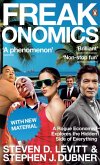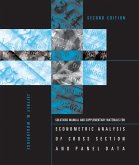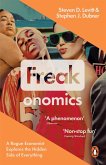Christiaan Heij ( Associate Professor at the Econometric Institute, Paul de Boer (Ass Assistant Professor at the Econometric Institute, Philip Hans Franses (Professor of Applied Econometrics and Professo
Econometric Methods with Applications in Business and Economics
With contrib. by Christiaan Heij, Paul de Boer and Philip H. Franses
Christiaan Heij ( Associate Professor at the Econometric Institute, Paul de Boer (Ass Assistant Professor at the Econometric Institute, Philip Hans Franses (Professor of Applied Econometrics and Professo
Econometric Methods with Applications in Business and Economics
With contrib. by Christiaan Heij, Paul de Boer and Philip H. Franses
- Gebundenes Buch
- Merkliste
- Auf die Merkliste
- Bewerten Bewerten
- Teilen
- Produkt teilen
- Produkterinnerung
- Produkterinnerung
Providing an understanding and experience of econometrics, this book covers basic econometric methods and addresses the creative process of model building. Using examples and exercises, it focuses on regression and covers choice data and time series data. It is aimed at undergraduate students, new graduate students, and applied researchers.
Andere Kunden interessierten sich auch für
![Econometric Analysis of Cross Section and Panel Data Econometric Analysis of Cross Section and Panel Data]() Jeffrey M. Wooldridge (University Distinguished Professor of EconomEconometric Analysis of Cross Section and Panel Data100,99 €
Jeffrey M. Wooldridge (University Distinguished Professor of EconomEconometric Analysis of Cross Section and Panel Data100,99 €![Introduction to Computational Economics Using Fortran Introduction to Computational Economics Using Fortran]() Hans Fehr (Professor of Economics, Professor of Economics, UniversiIntroduction to Computational Economics Using Fortran61,99 €
Hans Fehr (Professor of Economics, Professor of Economics, UniversiIntroduction to Computational Economics Using Fortran61,99 €![Freakonomics Freakonomics]() Steven D. LevittFreakonomics6,49 €
Steven D. LevittFreakonomics6,49 €![Limitarianism Limitarianism]() Ingrid RobeynsLimitarianism16,99 €
Ingrid RobeynsLimitarianism16,99 €![A Primer in Econometric Theory A Primer in Econometric Theory]() John Stachurski (Australian National University College of BusinessA Primer in Econometric Theory71,99 €
John Stachurski (Australian National University College of BusinessA Primer in Econometric Theory71,99 €![Student's Solutions Manual and Supplementary Materials for Econometric Analysis of Cross Section and Panel Data Student's Solutions Manual and Supplementary Materials for Econometric Analysis of Cross Section and Panel Data]() Jeffrey M Wooldridge (University Distinguished Professor of EconomiStudent's Solutions Manual and Supplementary Materials for Econometric Analysis of Cross Section and Panel Data50,99 €
Jeffrey M Wooldridge (University Distinguished Professor of EconomiStudent's Solutions Manual and Supplementary Materials for Econometric Analysis of Cross Section and Panel Data50,99 €![Freakonomics Freakonomics]() Steven D. LevittFreakonomics19,99 €
Steven D. LevittFreakonomics19,99 €-
-
-
Providing an understanding and experience of econometrics, this book covers basic econometric methods and addresses the creative process of model building. Using examples and exercises, it focuses on regression and covers choice data and time series data. It is aimed at undergraduate students, new graduate students, and applied researchers.
Produktdetails
- Produktdetails
- Verlag: Oxford University Press
- Seitenzahl: 814
- Erscheinungstermin: 5. März 2015
- Englisch
- Abmessung: 252mm x 194mm x 48mm
- Gewicht: 1718g
- ISBN-13: 9780199268016
- ISBN-10: 0199268010
- Artikelnr.: 15001700
- Herstellerkennzeichnung
- Libri GmbH
- Europaallee 1
- 36244 Bad Hersfeld
- gpsr@libri.de
- Verlag: Oxford University Press
- Seitenzahl: 814
- Erscheinungstermin: 5. März 2015
- Englisch
- Abmessung: 252mm x 194mm x 48mm
- Gewicht: 1718g
- ISBN-13: 9780199268016
- ISBN-10: 0199268010
- Artikelnr.: 15001700
- Herstellerkennzeichnung
- Libri GmbH
- Europaallee 1
- 36244 Bad Hersfeld
- gpsr@libri.de
Christiaan Heij is Associate Professor at the Econometric Institute of the Erasmus University in Rotterdam and specialises in econometrics and statistics. Paul de Boer is Assistant Professor at the Econometric Institute of the Erasmus University in Rotterdam and specialises in econometrics and statistics. Philip Hans Franses is Professor of Applied Econometrics and Professor of Marketing Research, both at the Erasmus University Rotterdam. He has published in leading international journals on applied econometrics, time series analysis, empirical finance, and marketing research. He is the (co-)author of various books published by Oxford University Press and Cambridge University Press. Teun Kloek is Professor Emeritus of Econometrics at Erasmus University Rotterdam. He has published in leading international journals on econometric theory, applied econometrics and quantitative economics. Herman K. van Dijk is Professor of Econometrics and director of the Econometric Institute of the Erasmus University in Rotterdam. His fields of research are Bayesian Inference and Decision Analysis in Econometrics, Computational Economics, Stochastic Trends and Cycles in Time Series Econometrics and Income Distributions.
Introduction
1 Review of Statistics
1.1: Descriptive statistics
1.2: Random variables
1.3: Parameter estimation
1.4: Tests of hypotheses
Summary, further reading, and keywords
Exercises
2 Simple Regression
2.1: Least squares
2.2: Accuracy of least squares
2.3: Significance tests
2.4: Prediction
Summary, further reading, and keywords
Exercises
3 Multiple Regression
3.1: Least squares in matrix form
3.2: Adding or deleting variables
3.3: The accuracy of estimates
3.4: The F-test
Summary, further reading, and keywords
Exercises
4 Non-Linear Methods
4.1: Asymptotic analysis
4.2: Non-linear regression
4.3: Maximum likelihood
4.4: Generalized method of moments
Summary, further reading, and keywords
Exercises
5 Diagnostic Tests and Model Adjustments
5.1: Introduction
5.2: Functional form and explanatory variables
5.3: Varying parameters
5.4: Heteroskedasticity
5.5: Serial correlation
5.6: Disturbance distribution
5.7: Endogenous regressors and instrumental variables
5.8: Illustration: Salaries of top managers
Summary, further reading, and keywords
Exercises
6 Qualitative and Limited Dependent Variables
6.1: Binary response
6.2: Multinomial data
6.3: Limited dependent variables
Summary, further reading, and keywords
Exercises
7 Time Series and Dynamic Models
7.1: Models for stationary time series
7.2: Model estimation and selection
7.3: Trends and seasonals
7.4: Non-linearities and time-varying volatility
7.5: Regression models with lags
7.6: Vector autoregressive models
7.7: Other multiple equation models
Summary, further reading, and keywords
Exercises
Appendix A: Matrix Methods
A.1: Summations
A.2: Vectors and matrices
A.3: Matrix addition and multiplication
A.4: Transpose, trace, and inverse
A.5: Determinant, rank, and eigenvalues
A.6: Positive (semi)definite matrices and projections
A.7: Optimization of a function of several variables
A.8: Concentration and the Lagrange method
Exercise
Appendix B: Data Sets
Index
1 Review of Statistics
1.1: Descriptive statistics
1.2: Random variables
1.3: Parameter estimation
1.4: Tests of hypotheses
Summary, further reading, and keywords
Exercises
2 Simple Regression
2.1: Least squares
2.2: Accuracy of least squares
2.3: Significance tests
2.4: Prediction
Summary, further reading, and keywords
Exercises
3 Multiple Regression
3.1: Least squares in matrix form
3.2: Adding or deleting variables
3.3: The accuracy of estimates
3.4: The F-test
Summary, further reading, and keywords
Exercises
4 Non-Linear Methods
4.1: Asymptotic analysis
4.2: Non-linear regression
4.3: Maximum likelihood
4.4: Generalized method of moments
Summary, further reading, and keywords
Exercises
5 Diagnostic Tests and Model Adjustments
5.1: Introduction
5.2: Functional form and explanatory variables
5.3: Varying parameters
5.4: Heteroskedasticity
5.5: Serial correlation
5.6: Disturbance distribution
5.7: Endogenous regressors and instrumental variables
5.8: Illustration: Salaries of top managers
Summary, further reading, and keywords
Exercises
6 Qualitative and Limited Dependent Variables
6.1: Binary response
6.2: Multinomial data
6.3: Limited dependent variables
Summary, further reading, and keywords
Exercises
7 Time Series and Dynamic Models
7.1: Models for stationary time series
7.2: Model estimation and selection
7.3: Trends and seasonals
7.4: Non-linearities and time-varying volatility
7.5: Regression models with lags
7.6: Vector autoregressive models
7.7: Other multiple equation models
Summary, further reading, and keywords
Exercises
Appendix A: Matrix Methods
A.1: Summations
A.2: Vectors and matrices
A.3: Matrix addition and multiplication
A.4: Transpose, trace, and inverse
A.5: Determinant, rank, and eigenvalues
A.6: Positive (semi)definite matrices and projections
A.7: Optimization of a function of several variables
A.8: Concentration and the Lagrange method
Exercise
Appendix B: Data Sets
Index
Introduction
1 Review of Statistics
1.1: Descriptive statistics
1.2: Random variables
1.3: Parameter estimation
1.4: Tests of hypotheses
Summary, further reading, and keywords
Exercises
2 Simple Regression
2.1: Least squares
2.2: Accuracy of least squares
2.3: Significance tests
2.4: Prediction
Summary, further reading, and keywords
Exercises
3 Multiple Regression
3.1: Least squares in matrix form
3.2: Adding or deleting variables
3.3: The accuracy of estimates
3.4: The F-test
Summary, further reading, and keywords
Exercises
4 Non-Linear Methods
4.1: Asymptotic analysis
4.2: Non-linear regression
4.3: Maximum likelihood
4.4: Generalized method of moments
Summary, further reading, and keywords
Exercises
5 Diagnostic Tests and Model Adjustments
5.1: Introduction
5.2: Functional form and explanatory variables
5.3: Varying parameters
5.4: Heteroskedasticity
5.5: Serial correlation
5.6: Disturbance distribution
5.7: Endogenous regressors and instrumental variables
5.8: Illustration: Salaries of top managers
Summary, further reading, and keywords
Exercises
6 Qualitative and Limited Dependent Variables
6.1: Binary response
6.2: Multinomial data
6.3: Limited dependent variables
Summary, further reading, and keywords
Exercises
7 Time Series and Dynamic Models
7.1: Models for stationary time series
7.2: Model estimation and selection
7.3: Trends and seasonals
7.4: Non-linearities and time-varying volatility
7.5: Regression models with lags
7.6: Vector autoregressive models
7.7: Other multiple equation models
Summary, further reading, and keywords
Exercises
Appendix A: Matrix Methods
A.1: Summations
A.2: Vectors and matrices
A.3: Matrix addition and multiplication
A.4: Transpose, trace, and inverse
A.5: Determinant, rank, and eigenvalues
A.6: Positive (semi)definite matrices and projections
A.7: Optimization of a function of several variables
A.8: Concentration and the Lagrange method
Exercise
Appendix B: Data Sets
Index
1 Review of Statistics
1.1: Descriptive statistics
1.2: Random variables
1.3: Parameter estimation
1.4: Tests of hypotheses
Summary, further reading, and keywords
Exercises
2 Simple Regression
2.1: Least squares
2.2: Accuracy of least squares
2.3: Significance tests
2.4: Prediction
Summary, further reading, and keywords
Exercises
3 Multiple Regression
3.1: Least squares in matrix form
3.2: Adding or deleting variables
3.3: The accuracy of estimates
3.4: The F-test
Summary, further reading, and keywords
Exercises
4 Non-Linear Methods
4.1: Asymptotic analysis
4.2: Non-linear regression
4.3: Maximum likelihood
4.4: Generalized method of moments
Summary, further reading, and keywords
Exercises
5 Diagnostic Tests and Model Adjustments
5.1: Introduction
5.2: Functional form and explanatory variables
5.3: Varying parameters
5.4: Heteroskedasticity
5.5: Serial correlation
5.6: Disturbance distribution
5.7: Endogenous regressors and instrumental variables
5.8: Illustration: Salaries of top managers
Summary, further reading, and keywords
Exercises
6 Qualitative and Limited Dependent Variables
6.1: Binary response
6.2: Multinomial data
6.3: Limited dependent variables
Summary, further reading, and keywords
Exercises
7 Time Series and Dynamic Models
7.1: Models for stationary time series
7.2: Model estimation and selection
7.3: Trends and seasonals
7.4: Non-linearities and time-varying volatility
7.5: Regression models with lags
7.6: Vector autoregressive models
7.7: Other multiple equation models
Summary, further reading, and keywords
Exercises
Appendix A: Matrix Methods
A.1: Summations
A.2: Vectors and matrices
A.3: Matrix addition and multiplication
A.4: Transpose, trace, and inverse
A.5: Determinant, rank, and eigenvalues
A.6: Positive (semi)definite matrices and projections
A.7: Optimization of a function of several variables
A.8: Concentration and the Lagrange method
Exercise
Appendix B: Data Sets
Index
'. . . students will find the contents of this book to be a very helpful guide . . . Because of its wide coverage and careful presentation the book should be useful for a diverse group of students in many countries and interested in a variety of areas of applications.' C. W. J. Granger, Nobel Laureate








